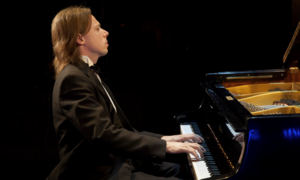It has often been observed that there is a close and symbiotic relationship between music and math, and that seemed to be on display at Reynolds Theater, both by examples of a unique combination of instruments and the improbability of the names of the performers. Duke Performances welcomed back to Duke both the Miami String Quartet and the Kalichstein-Laredo-Robinson (KLR) Trio, but for the first time here they were performing together. The seven musicians combined for interesting permutations of their members, in addition to the highly unusual coincidence that three of them have “Robinson” as their surname.
When one thinks of a chamber music work with two cellos, the magnificent C Major String Quintet by Schubert is the one that deservedly comes to mind, but Franz was not the first to add a second cello to a string quartet. Luigi Boccherini, the late 18th century cello virtuoso and prolific composer, wrote over one hundred works for two violins, viola and two cellos. Sharon Robinson, cellist of the KLR trio and former faculty member of Duke University, joined the Miami String Quartet for a performance of Boccherini’s Quintet in E, Op. 11, No. 5. The opening movement is a subdued amoroso that has all five strings playing con sordino (with mutes on) throughout the entire movement. For those who thought they were hearing an unfamiliar work, the Minuetto jumped out and was immediately recognized as one of the “greatest hits” in all of classical music. A sign of a great musician or ensemble is the ability to play such a familiar work and imbue it with surprises and personality – this quintet did just that. First violinist Benny Kim was especially playful and creative in his phrasing and breathed new life into this standard.
Question: name all of the works written for string quartet plus piano trio? Answer: one, and we got to hear that unlikely statistic tonight. Composer Ellen Taaffe Zwilich, the first woman to be awarded the Pulitzer Prize for music and the first to receive a doctoral degree in composition from Juilliard, is known for writing for unusual combinations, and she celebrated her 70th birthday with this Septet for Piano Trio and String Quartet. It was premiered in April, 2009, at the 92nd Street Y in New York City by these same artists. As if to compensate for the complete absence of music for this combination of instruments, Zwilich delved into a myriad of styles and compositional devices such as the Baroque passacaglia to ultra romanticism to a very authentic jazz treatment in the third movement. She also is quite effective in being able to gauge when enough is enough and the result is a compelling and eclectic work that should easily pass into the standard repertoire of chamber music.
Lose the second cellist and third violinist from the previous septet and you have the more common configuration of piano quintet, although there aren’t really all that many of these either. It is generally recognized that for this genre, the piano quintets written by Brahms, Schumann, and Dvořák are the kings of that hill. Tonight was the Czech master’s turn– a chamber music staple that is an unending wellspring of musical brilliance and great fun to play. Miami String Quartet cellist Keith Robinson and second violinist Cathy Meng Robinson went to the dugout while fellow band members first violinist Benny Kim and violist Yu Jin joined the KLR trio featuring violinist Jamie Laredo, pianist Joseph Kalichstein, and cellist Robinson for Dvořák’s Quintet in A Major for piano and strings. To extend the baseball metaphor, sometimes a shaky start can result in a fantastic performance and big win – and this was the case tonight. The beautiful opening cello theme was, well, simply botched with a scratchy sound and bad intonation. It seemed to take all the players by surprise and then took a minute or so to recover, but the performance ended up being one of supreme finesse, grace, and excitement. Dvořák often saves his most heartfelt and emotive writing for the slow movements, and violist Jin’s playing of the melancholy theme of the dumka, a Slavonic folksong, was a lesson on how the viola should sound. The ensemble playing was precise yet elastic when needed throughout, and the winding down near the finale of the work was played as one heartbeat before the joyous and spirited conclusion.











